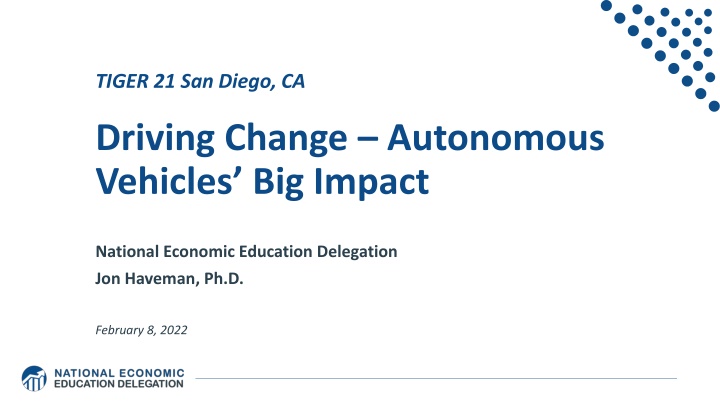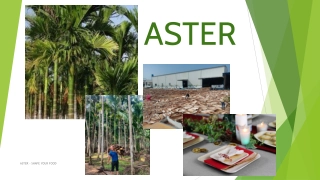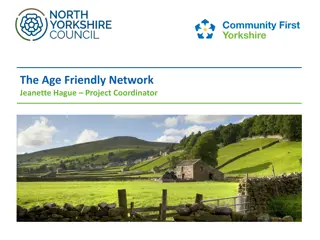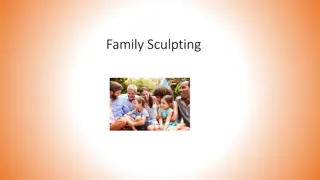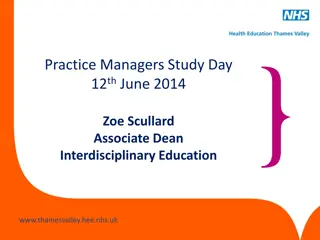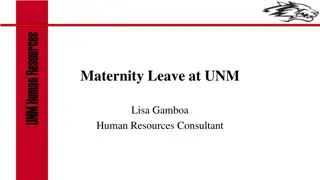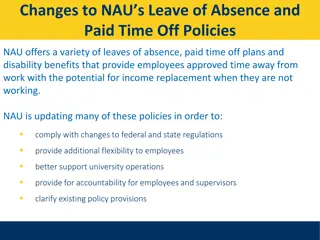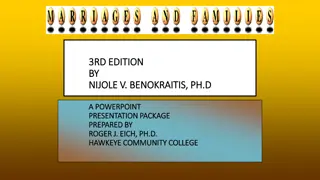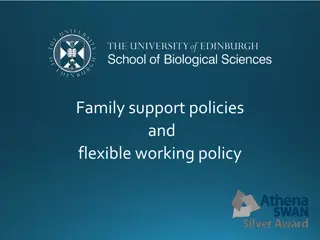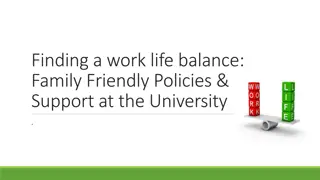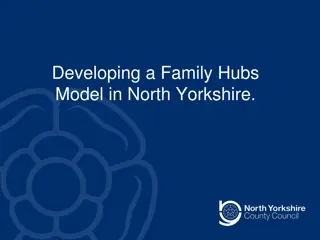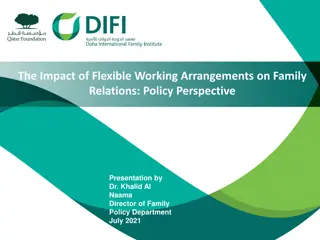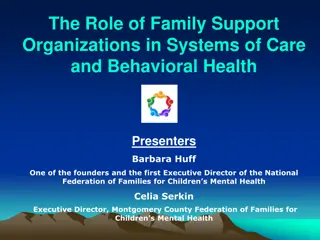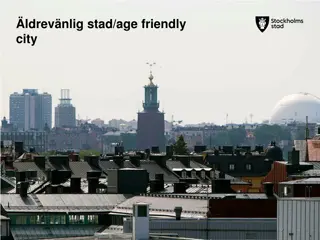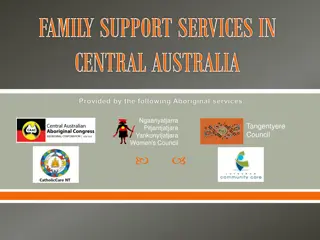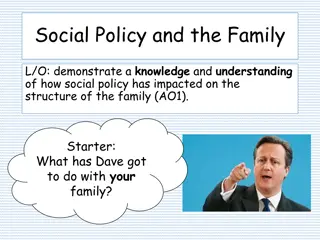Family-Friendly Policies & Support at University
University's family-friendly policies and support systems that aid in achieving work-life balance. Explore various guides like Adoption, Parental Leave, Flexible Working, and more to accommodate diverse family needs.
Download Presentation

Please find below an Image/Link to download the presentation.
The content on the website is provided AS IS for your information and personal use only. It may not be sold, licensed, or shared on other websites without obtaining consent from the author.If you encounter any issues during the download, it is possible that the publisher has removed the file from their server.
You are allowed to download the files provided on this website for personal or commercial use, subject to the condition that they are used lawfully. All files are the property of their respective owners.
The content on the website is provided AS IS for your information and personal use only. It may not be sold, licensed, or shared on other websites without obtaining consent from the author.
E N D
Presentation Transcript
TIGER 21 San Diego, CA Driving Change Autonomous Vehicles Big Impact National Economic Education Delegation Jon Haveman, Ph.D. February 8, 2022
National Economic Education Delegation Vision One day, the public discussion of policy issues will be grounded in an accurate perception of the underlying economic principles and data. Mission NEED unites the skills and knowledge of a vast network of professional economists to promote understanding of the economics of policy issues in the United States. NEED Presentations Are nonpartisan and intended to reflect the consensus of the economics profession. 2
Who Are We? Honorary Board: 54 members 2 Fed Chairs: Janet Yellen, Ben Bernanke 6 Chairs Council of Economic Advisers o Furman (D), Rosen (R), Bernanke (R), Yellen (D), Tyson (D), Goolsbee (D) 3 Nobel Prize Winners o Akerlof, Smith, Maskin Delegates: 649+ members At all levels of academia and some in government service All have a Ph.D. in economics Crowdsource slide decks Give presentations Global Partners: 48 Ph.D. Economists Aid in slide deck development 3
Available NEED Topics Include: Coronavirus Economics The U.S. Economy Climate Change Immigration Economics Economic Inequality Housing Policy Economic Mobility Federal Budgets US Social Policy Federal Debt Trade and Globalization Black-White Wealth Gap Minimum Wage Autonomous Vehicles 4
Credits and Disclaimer This slide deck was authored by: Jon Haveman, NEED This slide deck was reviewed by: Ronald Fisher, Michigan State University William F. Fox, University of Tennessee, Knoxville Disclaimer NEED presentations are designed to be nonpartisan. It is, however, inevitable that the presenter will be asked for and will provide their own views. Such views are those of the presenter and not necessarily those of the National Economic Education Delegation (NEED). 5
Outline Where does the AV path lead? Transition Policy/Planning Issues Major Economic/Development Changes
Growth Path McKinsey & Company
McKinsey isnt Always Spot On "In 1980, McKinsey & Company was commissioned by AT&T to forecast cell phone penetration in the U.S. by 2000. The consultant s prediction, 900,000 subscribers, was less than 1% of the actual figure, 109 Million. Professor Angel Lozano, 2014 9
WHEN? What do the headlines say? NVIDIA to introduce level-4 enabling system by 2018 First autonomous Toyota to be available in 2020 Volkswagen expects first self driving cars on the market by 2019 Elon Musk now expects first fully autonomous Tesla by 2019, approved by 2021 Audi to introduce a self- driving car by 2020
WHEN? What is possible? By 2025 (?) Potentially 95% of VMT by 2035. Last 5% may be very difficult to achieve. Is this possible? Horses to cars: 10 years early 1900s But adoption of EVs is so slow! Adoption of AVs will be rapid.
Forecast Timing may be off. But the point is: RAPID ADOPTION! The Big Unknown 13
Trucking Highly Fertile Ground Long haul trucking is likely the first place we will see it adopted. Reduces costs associated with drivers. End run around limits on hours of driving. Where does it stand? Lots of trials underway. TuSimple actively building a long haul network. Waymo focused more on last mile/local delivery. 15
But, will it be: Heaven? OR Hell?
Hell Primarily individual private car ownership Much as today. Internal combustion engines Why Hell? Dramatically increased VMT and pollution. Potentially increased congestion. Parking
Two Adults and a Child: Morning Miles Parking Office 1 1 2 3 4 School Home 5 7 6 Office 2 And this is just the morning .. 21
Heaven Vehicle ownership will be very limited Private ownership for those with specialized vehicle needs. Fleet ownership will serve everybody else. Engines: electric Not clear when we will get there, but this is the likely model. 2030 for widespread adoption in many regions.
Why is this Heaven? Not only autonomous, but: Shared Connected Green Far fewer cars in existence. Better resource utilization. VMT could go up or down, but more productive than in Hell. Congestion effects unclear, but likely reduced. Right-sized vehicles, platooning, sharing, V2V communication Minimal need for parking.
Economics Drives Transition: Private Adoption dividend for private individuals Eliminate car ownership o Ave annual cost of owning a car: $9,561 (2020) o Cost per mile will fall: $0.59 to $0.19 Repurpose your garage o $50,000 from transition to bedroom Time recovery 50% of the King County workforce has a commute in excess of 30 minutes.
Economics Drives Transition: Public Economic and social costs associated with human drivers are enormous: ACCIDENTS: o Drive 25% of congestion. o Result in 40,000 deaths. o And 2 million injuries. o 90+% caused by human error. Increased productivity from not driving. Costs of human drivers estimated at up to $1.3 TRillion each year
Potential Savings Morgan Stanley
Encourage Change Mobility and equity considerations Elderly/disabled/impoverished Safety: only way to reduce traffic fatalities is by coordinated effort Productivity: reduced congestion Environment: speed transition to electric vehicles These are all societal benefits that come about too slowly if the private market is left to itself.
Environmental Implications Depends: Heaven or Hell Improved resource utilization More efficient travel - Right sized vehicles - Optimized routes - Reduced congestion - No searching for parking Increased VMT Cleaner technologies - Electric - Lighter vehicles Energy use of onboard electronics - Weight and functional Increased urban sprawl Bottom line: push governments at all levels to embrace and to implement policies deterring private vehicle ownership and zero passenger miles
What Changes Will This Bring? Disposable income Government finances Transportation demand Infrastructure Public transportation Housing Employment Parking Potentially dramatic improvements in infrastructure planning and maintenance - Data sharing and integration
Public Transportation Ambiguous implications for public transportation Demand may: Shrink because of low cost of TaaS Grow because last mile problem is solved Extensions may be added through contract with TaaS company
Employment Massive job displacement/relocation (Millions!): Drivers of all varieties: truck, taxi, delivery Car production jobs, car parts production jobs Gas station, vehicle repair, and body shop Police and fire Health care workers And so on
Parking Greatly reduced demand for parking lots. Service providers will own parking lots in strategic places. Street parking will largely be a thing of the past. More green space in cities Shopping mall and apartment parking? Converted to housing?
Freeing Up Urban Space from Parking Los Angeles: 14% of incorporated land area 200 Square miles San Francisco: 275,450 on-street parking spaces Enough to parallel-park a line of cars 60 miles longer than California s entire 840-mile coastline Nationwide: (estimate) 500 million spaces That s larger than Delaware and Rhode Island combined. Could be as many as 2 billion (add in Connecticut and Vermont). 34
Potential Problems and Concerns Expansion of the electric grid to provide sufficient capacity. Mining for rare earth minerals for batteries. Hacking of autonomous vehicles for nefarious purposes. Competition in service provision in some markets. And many more 35
Investment Opportunities Parking lots/garages Transportation technology Certain residential properties Building apartment complexes 36
Summary of Change Massive employment upheaval. Local government finances will look very different. Housing will be easier to build and more plentiful. Parking conversions will be commonplace. Demand for transportation infrastructure will likely decline. Transportation infrastructure technology will be a booming business. Demand for public transportation may well decline. Coming likely sooner rather than later!
Thank you! Any Questions? www.NEEDelegation.org Jon D. Haveman Jon@NEEDelegation.org Contact NEED: info@NEEDelegation.org Submit a testimonial: www.NEEDelegation.org/testimonials.php Become a Friend of NEED: www.NEEDelegation.org/friend.php 38
